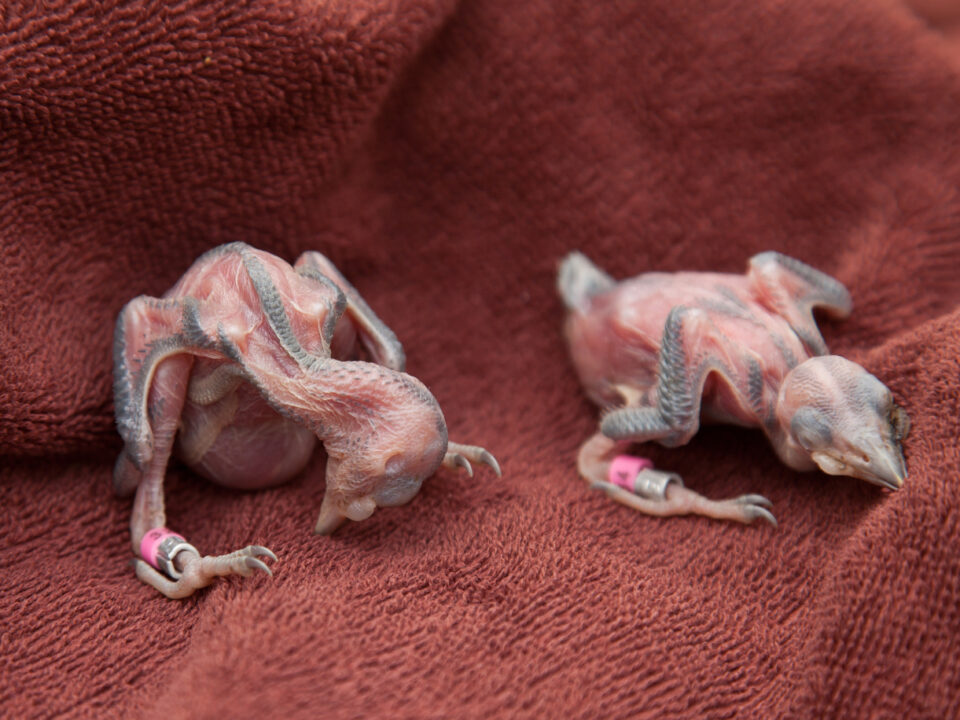Whimbrel Conservation on the Acadian Peninsula

Grace on James River at Chickahominy River Oct 1 2016
October 3, 2016
Grace Remains Along the James River Oct 7 2016
October 10, 2016
Atlantic Canada was documented as a major shorebird stopover location over a century ago. In the late 1800s, hunters used coastal habitats in the region to hunt Eskimo curlew, whimbrels, godwits, plovers, and other shorebirds for both sport and the markets in North America and Europe. Very little regional population data was gathered on whimbrels since the market gunner/sport hunting days. Those migrant shorebirds relied upon invertebrates and berries in bogs, heathlands, and mudflats to fuel their flights to wintering grounds.
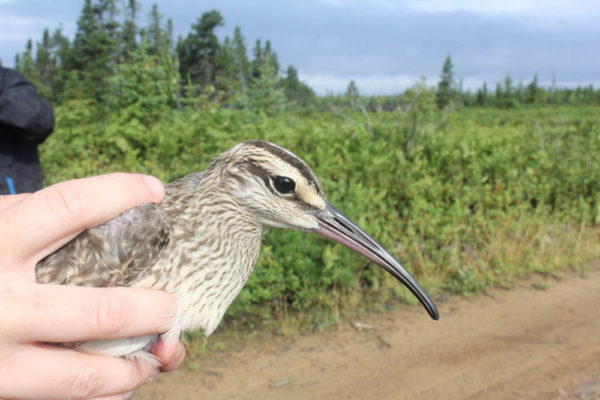
Whimbrel ready to be released. Photo by Fletcher Smith.
Beginning in the fall of 2014, The Center for Conservation Biology, along with collaborators at the Canadian Wildlife Service and Mount Allison University, surveyed the habitats available to whimbrels on the Acadian Peninsula of New Brunswick (bog, mudflat, beach/dune, and blueberry fields). Using a combination of aerial and ground surveys to cover the peninsula, we documented the stopover population on the peninsula and the habitat use of the birds while they stage there. In the past decade or so, whimbrels have shifted their use from natural habitats to the blueberry fields in the region, creating a conflict between growers and the birds. Blueberry fields are likely simulating the best of the bog and heathland habitat, with food resources many times that of the natural habitats (both in berries and invertebrates), and low, manicured vegetation that allows the birds to observe predators from a distance.
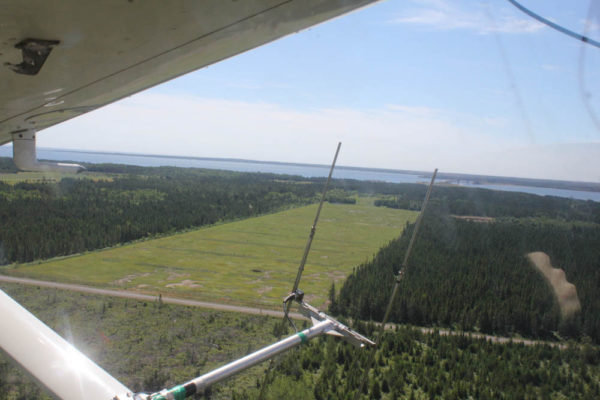
Aerial view of blueberry field. Photo by Fletcher Smith.
During the fall migration of 2016, seven whimbrels were trapped and outfitted with small solar powered satellite transmitters. The purpose of this study is to track the birds throughout their annual cycle, documenting habitat use while on the Acadian Peninsula, as well as to discover the wintering and breeding grounds of the birds that migrate through the region. The birds were tracked locally to evening roost locations, daily feeding areas, and loafing areas. They were recently tracked from the Acadian Peninsula and Prince Edward Island on five-day, 4,500 mile non-stop flights to Brazil. Brazil appears to be a crossroads of sorts for two of the three breeding populations of whimbrels.
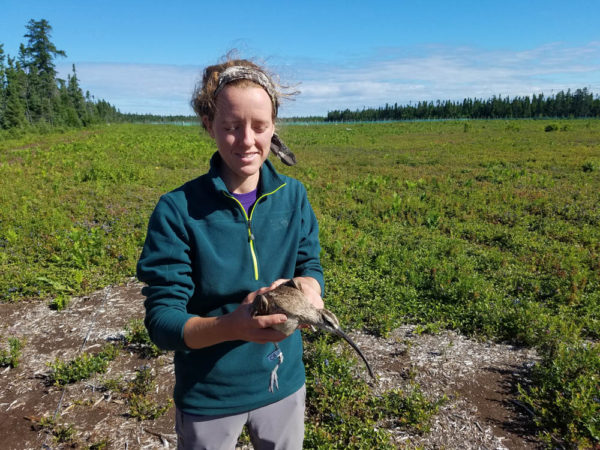
Avery Nagy-Macarthur prepares to release a satellite tagged whimbrel. Photo by Fletcher Smith.
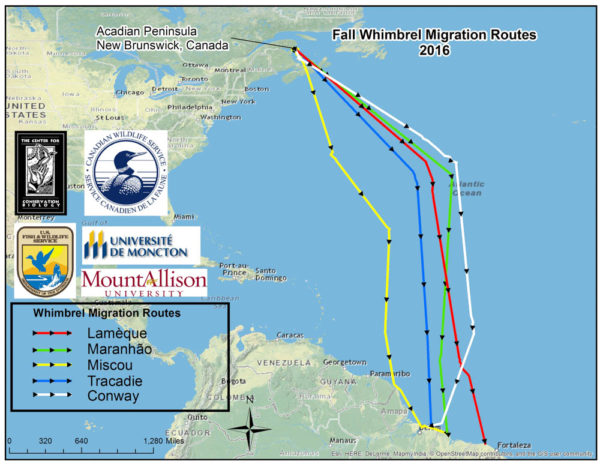
Migration routes of whimbrels tagged on the Acadian Peninsula, New Brunswick, Canada. Data from CCB.
Blueberry production is a multi-million dollar industry in the region, and interactions of whimbrels and blueberry farmers will likely increase as more berry fields are brought into production. Farmers use a variety of methods to deter birds (mainly gulls and whimbrels) from eating berries. These methods include scarecrows, propane cannons, shotguns, cracker and screamer shells, audio calls, warden presence, and many others. A study by Mount Allison in 2015 revealed that whimbrels eat a relatively benign amount of berries, not worth the extra money and effort in deterring the birds from landing in the fields. An outreach program by the University of Moncton, Shippagan Campus was initiated in 2015 with goal of providing this and other information to berry farmers and providing opportunities to school children to track the birds. Plans are underway to continue this collaborative effort next fall to better understand local patterns of movement and habitat use on the peninsula. You can track the whimbrels at Wildlifetracking.org.
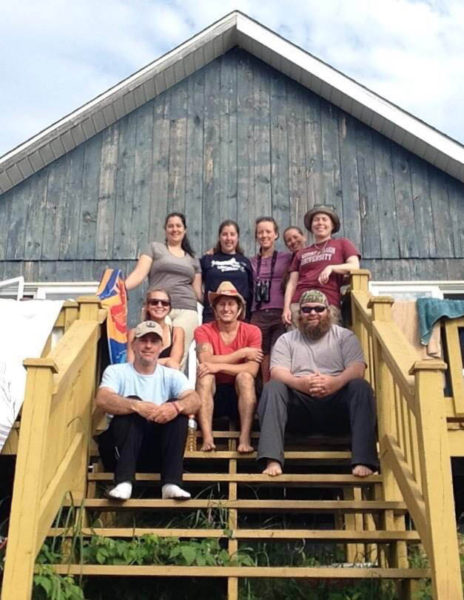
Crew members (left to right, back to front) Caitlyn Robert, Jessie McIntire, Avery Nagy-Macarthur, Julie Paquet, Beth MacDonald, Jess Hawkes, Patrick Champagne, Fletcher Smith, and in front Jason Mobley. Not pictured are Diana Hamilton and Julie Guillemot. Photo by Jason Mobley.
Funding, collaboration, and logistical support for this project was provided by the National Fish and Wildlife Foundation as part of the Atlantic Flyway Shorebird Initiative, the Canadian Wildlife Service, the U.S. Fish and Wildlife Service, Mount Allison University, the University of Moncton Shippagan Campus, and The Center for Conservation Biology at the College of William & Mary and Virginia Commonwealth University. We thank the blueberry farmers that allowed access into select blueberry fields and assisted with logistics.
Written by Fletcher Smith | fmsmit@wm.edu | (757) 221-1617
October 30, 2016
Related posts
Adult female from Elkins Chimney territory. Both the female and male were lost from this site between 2024 and 2025 nesting seasons and were not replaced. This territory has been occupied since 1995. Five territories were vacated between 2024 and 2025 along the Delmarva Peninsula in VA. Photo by Bryan Watts

